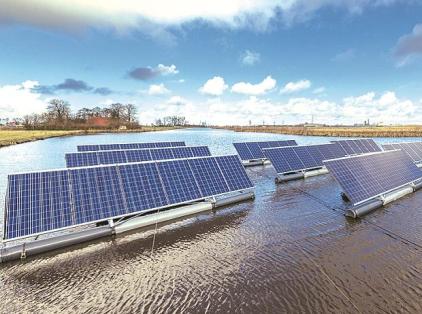Floating solar power may play a role in the Union government getting close to its target of 175,000 MW of renewable energy (RE) capacity by 2022, with the Ministry of New and Renewable Energy planning to add 10 GW of such capacity across the country as land availability presents a challenge. This is part of a global trend which has seen floating solar gain traction with policy-makers and developers—the global installed capacity is projected to reach 4,600 MW by 2022 from 1,100 MW in 2018.
As per industry estimates, utilising only 10-15% of India’s water resources for floating solar plants could generate up to 300,000 MW of power. The Solar Energy Corporation of India has already called for tenders to build 150 MW of floating solar capacity on the Getalsud and Dhurwa dams in Jharkhand, besides inviting bids for a 250-MW floating plant in Tamil Nadu. The Uttar Pradesh cabinet recently cleared a 150-MW floating solar project on the Rihand dam, requiring an estimated investment of Rs 750 crore. According to sources, the Damodar Valley Corporation is planning to install 100-MW of floating solar plants at its dams in Maithon, Panchet and Tilaiya, located in Jharkhand and West Bengal. Significantly, while floating solar plants can be set up on any freshwater surface, building them on the reservoirs of hydroelectric dams helps utilise existing transmission infrastructure and lower construction costs.
In this mode of renewable power, panels are mounted on floating platforms anchored either to the shore or the water bed. Though 70% of the earth’s surface is covered by water bodies, the existing technology is not able to tap the enormous opportunities offered by the oceans. High turbulence presents one challenge, being detrimental to the stability of panels, though the industry is exploring ways to overcome the problem. Also, since corrosion of solar structures can be harmful to the marine ecology, researchers are trying to make the technology more eco-sensitive. Higher upfront investment costs— $0.92-2.9 per watt depending on the location and technology requirements–pose another challenge. Sunil Rathi, director, Waaree Energies said that due to the use of special components like floats/pontoons, mooring systems and submerged water cables, the costs of a floating solar plant are 20-25% more than for ground-mounted solar at present.
Says Kuldeep Kumar Jain, business unit head-EPC, Vikram Solar said that besides the set-up required for a conventional ground- mounted system, a floating system installation requires specialists for underwater anchoring piling and special machinery for underwater work. His company had implemented a 10 kilo-watt floating solar project in Kolkata in 2015. He adds that the 1-MW floating solar plant being executed by Vikram Solar for Hindustan Zinc is one of the first MW-scale private floating projects in India. According to Bridge to India, a renewable energy consultancy firm, “sufficient domestic manufacturing capacity and growing volumes are expected to help reduce the cost disadvantage for floating solar projects to 10-15% by 2020”.
In what constitutes an advantage, floating solar projects produce 3-5% more power compared to land-based assets of a similar size, owing to the cooling effect of the water surface on panels. They can also help in water conservation by lowering the speed of evaporation from water surfaces. As Eicke Weber, professor, UC Berkeley, mentioned in his keynote address to the International Floating Solar Symposium in 2017, “more water evaporates from reservoirs than is consumed by humans”.
Source: Financial Express
Image Source: Business Standard

